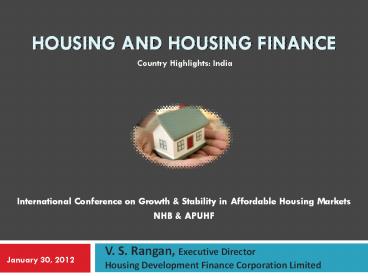Housing and Housing Finance - PowerPoint PPT Presentation
1 / 14
Title:
Housing and Housing Finance
Description:
HOUSING AND HOUSING FINANCE Country Highlights: India International Conference on Growth & Stability in Affordable Housing Markets NHB & APUHF V. S. Rangan, Executive ... – PowerPoint PPT presentation
Number of Views:2812
Avg rating:3.0/5.0
Title: Housing and Housing Finance
1
Housing and Housing Finance
Country Highlights India
- International Conference on Growth Stability in
Affordable Housing Markets - NHB APUHF
V. S. Rangan, Executive Director Housing
Development Finance Corporation Limited
January 30, 2012
2
COUNTRY HIGHLIGHTS
- India remains the second fastest growing economy
after China - It took 60 years after independence to reach US
1 trillion in 2007 - India will be a US 2 trillion economy by
2013-14 - Expected to be a US 4 trillion economy before
2020 - India is a domestic and consumption driven
economy - Consumption accounts for 70 of Indias GDP
- India is more insulated from global markets
compared to export oriented economies - Services sector contributes close to 60 of GDP
- Last 10 years have seen incremental but valuable
changes - Greater stabilisation
- Strengthening of the regulatory environment and
- The world recognised Indias potential
3
DRIVERS OF THE MORTGAGE MARKET IN INDIA
- Market Scenario
- High demand growth driven by
- Improved Affordability
- Rising disposable income
- Tax incentives (interest and principal repayments
deductible) - Affordable interest rates
- Increasing Urbanisation
- Favorable Demographics
- 60 of Indias population is below 30 years of
age - Rapid rise in new households owing to nuclear
families as against joint - Housing shortage estimated at 24.7 million units
- Rural14.1 million units, Urban10.6 million
units (Census Report)
4
RAPID URBANISATION
- Urbanisation Population
- 2011 31
- 2030(P) 40
- Number of cities with population gt1 million
- 2011 53 cities
- 2021(P) 75 cities
- Housing the urban population is challenging
- Growth in urbanisation has outpaced the ability
to provide adequate housing and urban
infrastructure - McKinsey estimates that Indian cities will
require US 1.2 trillion of additional capital
investment by 2030.
Source Census of India
5
MORTGAGES AS A OF GDP
6
LOW MORTGAGE PENETRATION IMPLIES ROOM FOR GROWTH
Mortgage to GDP ratio projected at 20 by 2020
- Mortgage to GDP ratio currently estimated at 9
compared to 2 in 2002 - Mortgages comprise the largest component in
banks retail portfolio - Mortgages have grown from 1.5 of banks advances
to 10 over the last 10 years - BCG-IBA Report estimates that outstanding
mortgages will increase 8 fold from Rs. 5
trillion currently to Rs. 40 trillion by 2020.
Source BCG-IBA Report, HDFC estimates
7
BANKS V/S HFCs
8
MORTGAGE FINANCE KEY PLAYERS
- Major Players
- Banks
- Housing Finance Companies (HFCs)
- Banks became major players in the mortgage
market only from the late 1990s - As per the ICRA Report on housing
- Market share in FY11
- Banks 69
- HFCs 31
- Top 3 players dominate the market combined
share of 48 - Asset quality for HFCs and banks have been good
- Most banks and HFCs target customers in the
formal sector, but a few new players are focusing
on the informal sector
Source ICRA
9
INITIATIVES TO STRENGTHEN MORTGAGE FINANCE
- Implementation of Foreclosure Norms
- No foreclosure norms existed till 2002
- Securitisation and Reconstruction of Financial
Assets and Enforcement of Security Interest Act,
2002 (SARFAESI) enacted to facilitate recovery of
defaulted loans - Helped reduce non-performing assets and brought
discipline amongst borrowers to repay loans - Credit Bureau
- Indias first credit bureau established in 2000
- Has helped in strengthening the credit appraisal
process - NHB RESIDEX
- Index to monitor city wise residential price
movements - Mortgage Registry
- The Central Registry of Securitisation Asset
Reconstruction and Security Interest of India
(CERSAI) became operational in March 2011. - Central registry helps to reduce frauds arising
from multiple lending by different lenders on the
same immovable property - Mortgage Guarantee/Insurance
- Credit risk will be mitigated to some extent,
thereby encouraging lenders to provide loans to
those from the informal sector or lower income
groups
10
NO IMPACT OF THE SUBPRIME CRISIS ON INDIA
10
- Most mortgage lenders offer vanilla, amortising
home loans - No interest only, 2/28 ARMs, piggy-back loans
- No subprime or Alt A categories
- Borrowers are cautious and averse to high
leverage - Typical borrower is a first time home buyer
- Low loan to value (LTV) ratio
- Prepayments are common
- Cash not asset based funding
- Securitisation market at a nascent stage, limited
exposure to structured products - Financial institutions have limited direct
exposure to US subprime mortgages - Timely intervention by the regulators to prevent
build up of any real estate bubble - Increased risk weights and provisioning
requirements - Prevented banks/HFCs from financing land
11
Counter Cyclical Prudential Regulation Retail
Housing Loans
Source Financial Stability Report, December
2011, RBI
12
Counter Cyclical Prudential Regulation
Commercial Real Estate
Source Financial Stability Report, December
2011, RBI
13
ROAD FORWARD
- Housing
- High cost of land in metropolitan cities hinders
affordable housing - Urban infrastructure upgradation
- Single window clearance for approvals
- Invest in low-cost building technology, prefab
housing - Investment linked tax incentives for developers
to increase the supply of affordable housing - More effective public private partnerships to
tackle the shortage of housing especially in the
low income group - Housing Finance
- Deepen the debt market to ensure availability of
long-term funding - Encourage development of new funding instruments
such as covered bonds - Securitisation still at a nascent stage
- Helpful for smaller housing finance players so
they do not need to keep raising capital - Introduce a specialised institutional mechanism
for providing credit enhancement which will
enable smaller players to obtain investment grade
ratings on the securitised pools
14
THANK YOU































